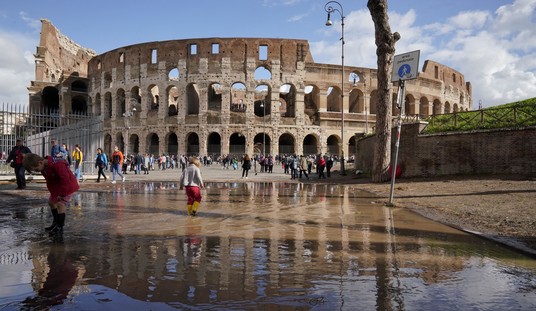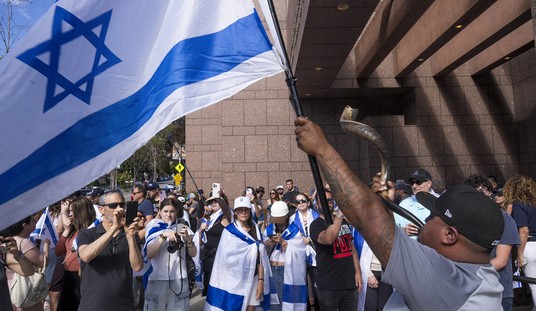Stupid, but unfortunately this stupidity is baked into the jurisprudential cake due to the intractability of the underlying problem. It’d be nice to set a bright-line rule about religious symbols on state land, where they’re either always okay or never okay. But neither of those positions works. You can’t have a system where they’re always okay or else you’re inviting overt attempts at religious indoctrination by the government. That would violate the Establishment Clause. At the other extreme, you can’t have a system where religious symbols are never permitted. Imagine trying to remove the crosses at Arlington National Cemetery. Necessarily the analysis in cases about monuments is ad hoc, and just as necessarily that sort of analysis depends on the judge’s subjective view.
Courts are left trying to feel their way case by case, essentially taking a “I know it when I see it” approach to unconstitutional government-financed religious symbolism. Normally that involves applying something called the “Lemon test,” drawn from a SCOTUS case of the same name, which tries to standardize judicial reasoning in analyzing cases like these. But it ends up as a hash in practice, with judges essentially using it to wrestle with the concept of de minimis indoctrination. Every religious symbol on government land risks indoctrinating the observer a little bit. Invariably the symbols are tied to virtues like heroism in war, in law enforcement, and so on. If you admire the valor of a soldier and a giant cross stands before you to commemorate that valor, maybe you’ll admire the cross and what it represents a little bit more too. But how much more? How much indoctrination is too much for the Establishment Clause?
A 40-foot cross at an intersection? Too much, says the Fourth Circuit:
Built in 1925 with funding from local families and The American Legion, the marble-and-cement cross honors 49 Prince George’s County men who died in the war. On the base are the words: valor, endurance, courage and devotion. A bronze tablet lists the names of the men and includes a quote from President Woodrow Wilson. The monument is part of a larger memorial park in the immediate area honoring veterans of several wars…
The Maryland-National Capital Park and Planning Commission, a state agency, owns the land and monument, and has spent about $117,000 to maintain and repair the cross, in addition to setting aside $100,000 for renovations…
The initial challenge in Maryland was brought by the American Humanist Association, a Washington-based group that represents atheists and others. The group did not dispute the monument is a memorial, but said in court that a giant cross on government property sends a message of exclusion in violation of the First Amendment…
In response to the 4th Circuit ruling on Wednesday, the humanist association’s executive director, Roy Speckhardt said, “government war memorials should respect all veterans, not just those from one religious group.”
Here’s the opinion, which duly applies the “Lemon test.” Does the monument have a secular purpose? Is its primary effect one that neither advances nor inhibits religion? Does it foster an excessive government entanglement with religion? Well, says the court, it does have a secular purpose in honoring the dead of World War I, but … it’s a cross. A really big cross. It’s farking huge! You can’t miss it:


Granted, says the court, there are also crosses at Arlington — many, many, many, many more than there are at this Maryland memorial — but those are little bitty crosses by comparison. And there aren’t just crosses there but Jewish stars, Muslim crescents, and so on, although the vast majority of symbols on the headstones are, of course, Christian. End result: The ol’ “Lemon test” for measuring de minimis religious indoctrination by the state is now literally a test about size, at least in part. The cross is just too damned big for constitutional comfort, raising a ridiculous new question about how small the First Amendment requires Christian symbols to be. See what I mean about the law in this area being a goofy hash?
To my mind, the mere fact that the cross is part of a war memorial should have been the end of the analysis. Obviously observers make intellectual allowances for religious symbolism when they’re at a site honoring the dead. As with the headstones at Arlington, the symbolism is viewed not so much as a state endorsement of religion as the deceased’s endorsement of religion. Same here, assuming most of the men honored at the site were Christian (a safe assumption). But even there, you could imagine absurd hypotheticals that would test your reasoning. Imagine a gigantic statue of Christ on the scale of the one in Rio with a huge plaque reading “BELIEVE” and a teeny tiny plaque underneath reading “Dedicated to America’s war dead.” Is that still a de minimis Establishment Clause infraction? That’d be a fun one for Neil Gorsuch to wrestle with, in case anyone reading this feels like sculpting.
Anyway. If you’re annoyed by the court’s decision, know that I am too even though I’m a nonbeliever. This is horribly bad PR for the non-religious, most of whom (I think) take the fact that America is a religious country in stride and are used to occasional religious symbolism being used in ceremonies. Sinister attempts at real religious indoctrination by the state are mercifully rare. This sort of lawsuit makes a mockery of that.







Join the conversation as a VIP Member